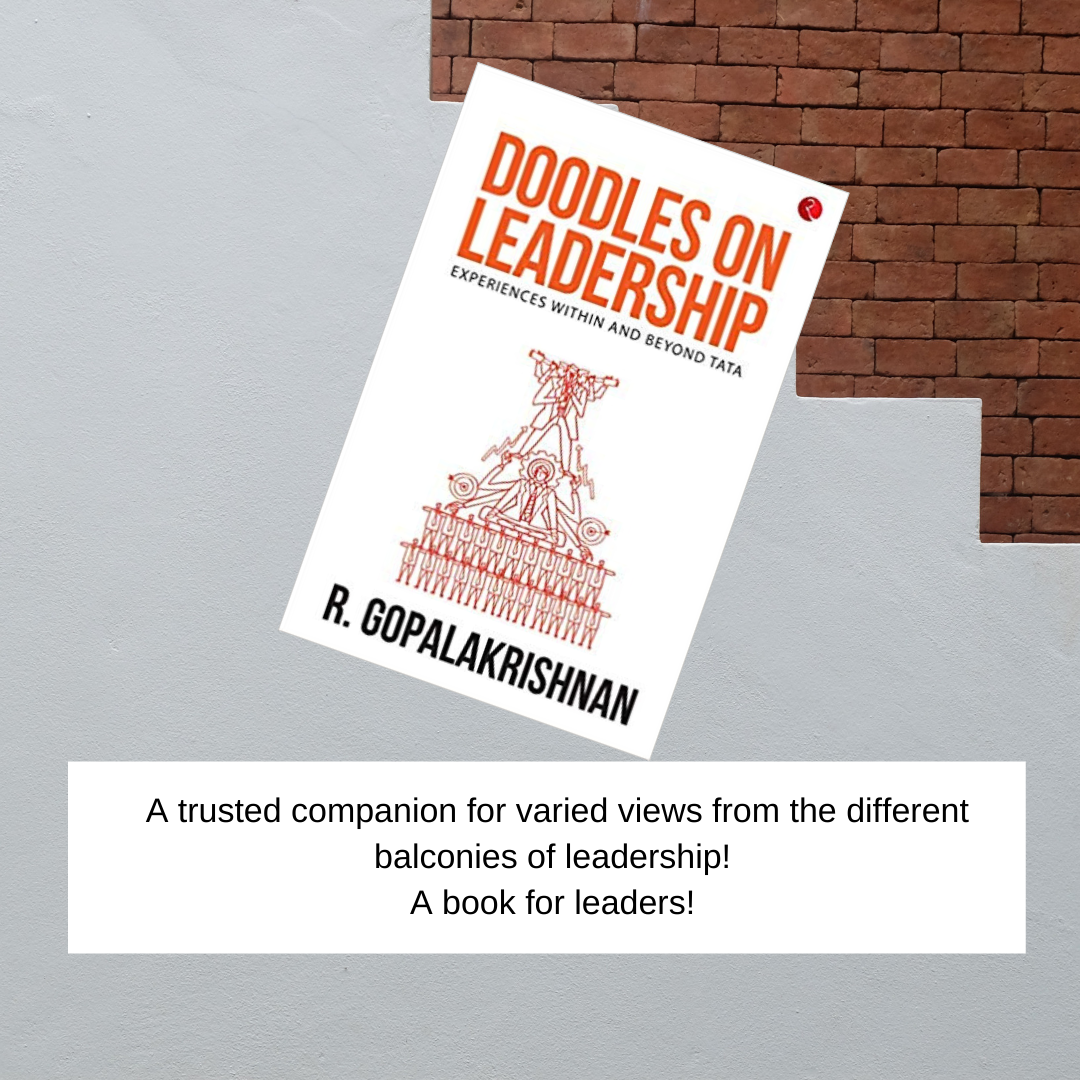How do we view leaders in the corporate world? As leaders in the business arena evolve to higher stages in their career, the issues they grapple with also change. The macro views that they hold and their perspectives also evolve. The metaphor of “balconies of leadership” is a powerful one. Over a successful corporate career of five decades, R.Gopalakrishnan proposes and takes an insightful and refreshing look at this concept of balconies of leadership, in his book, Doodles on Leadership (Rupa Publications).
Doodles on Leadership consists of insightful chapters on issues that concern leaders. These issues are not only to do with managing the business. The concerns encompass society itself. The book sees businesses as entities that make a positive impact on the world around them.
“It was a tradition in Tata that the group’s leaders would play an important role national economic development over several decades. I was one of the inheritors of that mantle” says the author. True to this statement, Doodles on Leadership draws on his extensive experience over the years. The varied chapters in the book explore different aspects of leadership in the broad context of society and of the country.
Here is a brief glimpse of few of the ideas in Doodles on Leadership…
Measuring innovation- innometer
Constant innovation is a key part of a business. I think a good takeaway for the reader is the idea of encouraging innovation. It is seen through the example of the Tata Group in this book. How can one measure innovation? How can a company encourage it? Does cross-department or cross-company collaborations act as catalysts? One of the chapters explores innovation in detail.
Trusteeship
Perhaps the biggest conflicts in businesses pertains to the seeming incongruity between humanity and humane aspects on one hand, and business goals on the other. Can these two streams ever flow together? This brings us to the concept of trusteeship. Indeed, Mahatma Gandhi has written about this concept of trusteeship as well, in a seminal work. Since inception, the Tata Group has been adhering to the principles of trusteeship as well.
In the book, by talking about Tata’s commitment to trusteeship, Gopalakrishnan goes on to show how business leaders can be instruments of positive change and contribution to society. He shows how a leader is a servant of society. Through the example of the Tata’s the readers will hopefully imbibe this viewpoint, and get pointers as to how they can translate this practically into their own businesses. The book shows that businesses can be humane and give back to society, and still be successful!

The only constant…
The examples given in the book focus on a crucial period of change in the Indian business scenario- the economic liberalization in the early 1990s. Indeed, those were the days of profound change and companies had to face new conditions and new uncertainties. When we read this book today, in hindsight, it is natural to draw parallels with the magnitudes of change that we see taking place all around us. However, now these changes are due to technology more than anything else. The book provides an interesting account of how big conglomerates like HLL and the Tata Group grappled with these changes. While the context of these changes has roots in the economic liberalisation of the time, the lessons and inferences that we can draw today in face of other changes are as relevant.
CEO tales….
Succession planning, the change of guard, cleaning up the mess left behind by an outgoing CEO, dealing with narcissistic leaders…these are just some of the top leadership issues that a new CEO may face. One of my favourite chapters in the book concerns these issues. Well, this is no doubt another view from these balconies of leadership!
The Indian angle
The book talks about the more satisfying ways that business leaders can engage with society. There is a chapter that focuses on little India- namely the rural India that has been somewhat left outside the growth side. In providing a helicopter view of the issues that pervade this humongous part of the country, he provides his unique perspective which I find quite refreshing. In similar vein he also discusses the judicial system of the country.
My favourite chapter in the book is the last one, where the author talks about India’s rich tradition of entrepreneurship. He proudly placed this at par with modern corporations, seeing them as an extension of sorts to this heritage.
How do all these topics tie up with leadership in the corporate arena? In fact, they do! These are broader issues that corporates should also be concerned with.
Maybe it is the build-up of pride of the Indian spirit, that beautifully integrates the role of business in society that makes Doodles on Leadership very inspiring! R.Gopalakrishnan provides a very holistic approach to leadership and the relevance of good leaders to society as a whole- not just businesses! So, when he quotes in the book, “I consider my career to be devoted to the national good, no less than the best in defence and administration,”, one sincerely hopes more businesses think on similar lines!
Doodles on Leadership will be of interest to people in positions of leadership as well as those who aspire to be leaders. The book is a companion as you move upwards towards growth and prosperity. But, you may need to pause, and take stock of your direction from different vantage points- from the varied balconies of Leadership! And at those times, I am sure, you will find that this book will prove to be a trusted guide!





